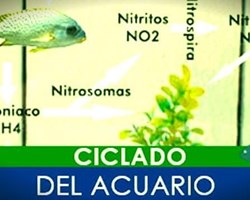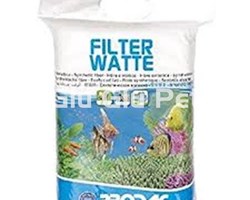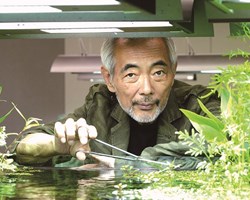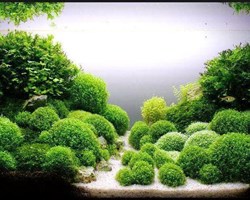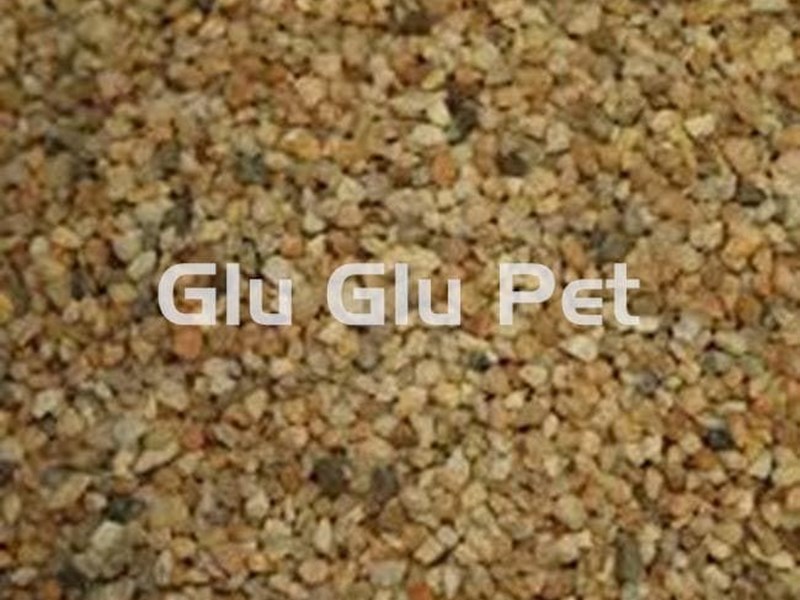
INDEX:
1.- THE AQUARIUM SUBSTRATE AND ITS ADVANTAGES.
2.- NUTRITIVE SUBSTRATES FOR AQUARIUMS.
2.1.- TYPES OF NUTRITIVE SUBSTRATES.
2.1.1.- ENRICHED SUBSTRATE.
2.1.2.- SOIL TYPE SUBSTRATE.
2.2.1.- JBL AQUABASIS SUBSTRATE.
2.2.2.- MANADO JBL SUBSTRATE.
2.2.3.- HELP ADVANCED SOIL PLANTS.
3.- TYPES OF INERT SUBSTRATES: SANDS AND GRAVELS.
3.1.-ADVANTAGES AND DISADVANTAGES OF THE INERT SUBSTRATE.
3.2.- SAND FOR AQUARIUM.
3.3.- JBL SANSIBAR RANGE OR DECORATIVE AQUARIUM SAND.
3.4.- JBL PROSCAPE VOLCANO MINERAL.
4.- CLAY SUBSTRATES FOR THE AQUARIUM.
5.- WHAT TYPE OF FLOOR TO LAY ACCORDING TO THE LEVEL OF EXPERIENCE.
6.- HOW TO CALCULATE THE QUANTITY OF SUBSTRATE FOR A PLANTED AQUARIUM.
1.- THE AQUARIUM SUBSTRATE AND ITS ADVANTAGES:
Choosing the best substrate for your aquarium is one of the first things we have to take into account when setting up our aquarium.
If you are starting with aquariums, surely you have wondered what the difference is between the different types of substrates, their advantages or disadvantages or if you can avoid putting substrate for the aquarium, first of all I have to tell you that the use of substrate is highly recommended in our aquariums since together with the filter they house the largest number of beneficial bacteria for the balance of our aquarium.
It has different functions:
- Promote the development of bacteria, which will help complete the nitrogen cycle.
- Although it may seem like a source of dirt, it actually plays a very important role in maintaining the aquarium ecosystem, and if we also have plants, it will serve to support its roots.
- Aquarium plants are very important and we must weigh a lot whether to place them or not.
At Glu Glu Pet we recommend its use, obviously its choice has a lot to do with the type of aquarium, the species of fish that we are going to take care of, etc.
But they are essential to maintain the health of the aquarium, just like the substrate.
In the market you will find a significant number of substrates, although they can basically be divided into three large groups:
- The inert.
- The nutritious.
- The clay ones.
The aquarium substrate is the base in which aquatic plants take root, ensuring support and a supply of vital nutrients to grow optimally.
It is an "aquarium soil" in which, in addition, beneficial bacteria settle for filtration and the correct assimilation of nutrients by the plants in the fish tank.
In nature, aquatic plant substrates vary greatly in mineral and organic composition and texture.
On the contrary, in a large number of aquariums it is still not possible to adequately cover the needs of aquatic plants in terms of substrate. We must know how to identify what our plants need.
Many aquatic plants absorb large amounts of nutrients through their roots, others do not. In these cases, the aquarium substrate should serve them not only to settle, but also to feed and expand.
For an aquarium substrate to be effective, it has to meet the following requirements:
- That the grain size of the aquarium substrate is optimal. A substrate with grains that are too coarse will allow the flow of aquarium water to pass through too easily, washing away nutrients and preventing plants from absorbing them. An aquarium substrate with grains that are too fine can compact, disrupting the flow of oxygen and nutrients, and causing damage to plant roots. The best substrate for a planted aquarium should have particle sizes between 1 and 3mm thick.
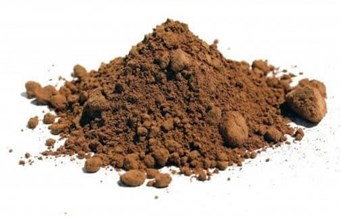
Other substrates of greater or lesser thickness, such as sand, can be used as a decorative complement in areas of the aquarium where planting is not planned, for example to shape paths or sand clearings without vegetation, which can give a lot of life to an aquatic landscape.
2. That the grain shape of the aquarium substrate is not harmful to the roots. It is preferable that the substrate has grains with a more rounded shape so that they do not damage the roots of the natural plants in the aquarium. Avoid as much as possible using substrate for aquarium plants whose particles are "sheer" or sharp edges, that would not benefit the fish either. Sand substrates have sharp microscopic edges, they are not recommended if you are going to keep fish that stir the bottom, but if not, it can be included in the areas of the aquarium where you will not plant.
3. The aquarium substrate has a complete and non-detrimental mineral content. Most of the substrates that are commercialized today have the most basic mineral components that plants need, although not all. It is usually necessary to supplement with periodic contributions of liquid fertilizer. What must be taken into account before buying a substrate for aquarium plants is that its composition is not calcareous. Calcareous substrates, such as certain sands formed by the remains of shells, corals or other marine structures of calcium carbonate, increase the alkalinity, gH or concentration of carbonates and bicarbonates, and the pH in the aquarium water, hindering the absorption of CO2 and nutrients by plants. Calcareous substrates could be used in case our tap water is very soft, very low gH and pH, naturally, and we need to increase those parameters of the aquarium to keep some species of fish or plant. But they are generally not recommended.
4. Optional and in many cases preferable: that they be nutritious. These substrates, unlike gravel or inert stones, contain the amount of organic and inorganic matter necessary to act as fertilizer for aquarium plants. They can be placed under aquarium sand or gravel or used alone, depending on the type of planted aquarium nutrient substrate used. Most brands market nutrient substrates that can be used unsealed with inert gravel, but they will still release large amounts of nutrients into the water column and if you are a beginner you will have a hard time managing your aquarium. If you are just starting out, it is recommended that you try some type of inert gravel, or well-sealed nutritious substrate and manually fertilize.
2.- NUTRITIONAL SUBSTRATES FOR AQUARIUMS:
Nutrient substrates for planted aquariums are substrates that can modify the parameters of the aquarium, because they are loaded with organic and inorganic matter, fertilizer for aquarium plants, and they do provide nutrients to aquatic plants.
These types of substrates are incredibly useful if we are going to maintain certain plants, except mosses and algae, among others, that use stones or logs as a substrate.
The granulometries of the nutritive substrate are very varied, from the clay or laterite substrate, with a very small granulometry, to the enriched or soil-type substrates with a larger grain size.
Tip: Whenever you are going to use a commercial unsealed nutrient substrate with gravel, place a layer of thicker, more porous material, such as lava rock substrates, under the substrate. This will allow the roots to set better.
2.1.- TYPES OF NUTRIENT SUBSTRATES:
2.1.1.- ENRICHED SUBSTRATE:
Enriched aquarium substrates are nutritious substrates that have been specifically designed for planted aquariums.
They are generally composed of a laterite base, plus additional organic and mineral matter that releases large amounts of nutrients over long periods of time.
There is enriched aquarium substrate with a smaller granulometry to combine with inert gravel, and currently they have also developed substrates to be used alone, as a single layer, which has been a great advance in the world of planted aquariums.
This type of aquarium substrate is not only practical but also very aesthetic, it usually has black or earthy brown colours.
Some are designed to modify aquarium parameters to the optimal levels for aquarium plants.
Placing an enriched aquarium substrate as a single layer should achieve a thickness of approximately 8-9 cm at the back and 4-5 cm at the front.
It also depends on the type of plants you want to put, if they have very large roots you will need a thicker substrate, and if they have small roots, such as some aquarium ground plants, a smaller thickness will be worth it.
Previously investigate the characteristics of the aquatic plants that interest you.
2.1.2.- SOIL TYPE SUBSTRATE:
If you are a beginner in the aquarium hobby, avoid soil-type substrates, because if they are not used carefully, the results can be catastrophic.
Experienced aquarists may find soil-type aquarium substrate to be one of the best long-lasting substrates.
It contains large amounts of iron and carbon, very beneficial for aquatic plants, and many other nutrients that are released slowly.
If you ultimately decide to use a soil-type aquarium substrate, lay down a 1-1/2-inch thick layer covered by another 1-inch layer of fine gravel.
The safest thing is to use compost for plants, potting soil, sterilized, never garden soil, to avoid contaminating the aquarium.
Since the soil-type aquarium substrate has a very high content of organic matter, its slow decomposition releases CO2, which is very useful for the photosynthesis of aquatic plants and it is not usually necessary to add additional CO2, which represents savings.
Nor is it necessary to supplement with other types of fertilizer, or with iron supplements.
During the first week of use, the substrate will release a large amount of nutrients and organic matter. Plants should be able to deal with it, but sometimes it creates dangerous conditions for aquarium fish.
For this reason, it would be good to wait a few weeks before introducing the fish, carbon filtering or doing regular water changes. The parameters of the aquarium must be controlled.
For beginners, it is much safer to use substrates that, although somewhat more expensive, are specifically designed for aquariums and are a much more predictable option than soil-type substrates.
2.2.1.- JBL AQUABASIS SUBSTRATE:
JBL Aquabasis Nutrient Substrate is one of the most widely used substrates for planted aquariums.
It has a very affordable price and gives good nutritional support to plants.
It provides practically all the necessary microelements and trace elements.
It does not contain nitrates or phosphates, so you must pay them yourself.
It has an important part of clay, so the substrate will store nutrients that it sequesters from the water column; calcium, magnesium, etc., and will facilitate their absorption by the roots of aquarium plants.
It is not the most powerful nutritional substrate, but it is very good if you are a beginner, since aquatic plants grow well and you will not have much nutrients released into the water column.
Controlling the parameters of your aquarium will be easier.
It is intended to be placed under the JBL manado substrate, to seal it.
Available in 2.5 liter bags: for 50 to 100 liter aquariums, and in 5 liter bags: for 100 to 200 liter planted aquariums.
Buy it at Glu Glu Pet:
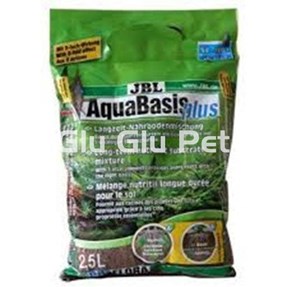
2.2.2.- JBL MANADO SUBSTRATE:
JBL Manado Substrate is a natural, non-enriched substrate.
It does not contain nutrients, and is designed to be combined with the Aquabasis, which is nutritious.
The Aquabasis + Manado substrate combination is very good for beginners, since it gives you the advantages of having an enriched substrate, you provide nutrients to the plants with the Aquabasis, and the advantages of not having it, nutrients are not released in unwanted quantities to the column of water, because we cover the nutritious with Manado.
Keep in mind that the substrate will absorb the fertilizers you add to the water until it becomes saturated, so during the first 2 weeks approximately, practically all the nutrients you add will be "sequestered" by the substrate.
It will then slowly release them, making them available to plants.
It has an average granulometry of 0.5 to 2 mm, with rounded grains, very suitable for plants and bottom fish.
The color is a very natural earthy brown, it gives a wild look to the aquarium.
Very affordable price and quality highly regarded among aquarists.
Perfect to start.
They are sold in bags of 1.5, 3, 5, 10 and 25 L.
2.2.3.- HELP ADVANCED SOIL PLANTS SUBSTRATE.
Perhaps the best planted aquarium substrate out there.
It is one of the substrates with the highest amount of nutrients on the market.
It is a powerful nutritional substrate.
This, depending on whether you know how to control it or not, can be good or bad.
At Glu Glu Pet we recommend that you put the HELP only in the areas of the aquarium where it will be planted.
The rest of the areas can be covered with an inert decorative substrate such as gravel or sand.
In this way we will make sure to put only the necessary amount of nutritious substrate.
If you put more, it is likely that the nutrients will be released in excess into the water column and you will be greatly disturbed by the parameters of the aquarium.
If you cover the entire bottom with HELP Advanced Soil, then make sure to completely fill the tank with fast-growing plants, so that they absorb as much of the nutrients as possible and are not released into the water.
Setting up a Dutch type aquarium, in which there are so many plants that you can't even see the bottom, is the only case in which it is justified to completely cover the aquarium floor with HELP.
If you are only going to put a couple of anubias or eleocharis it is better that you try another brand.
Another consideration is that this nutrient substrate LOWERS the pH and kH.
This aquarium substrate is pure dynamite of nutrients, if you use it well, aquatic plants will grow amazingly.
But make sure to do 50% water changes every 3 days or so for the first few weeks to control excess nutrients, and to completely cover the substrate areas with plants.
It is not necessary to cover or seal it with any other aquarium substrate, but it is highly recommended to place another layer of pumice or volcanic rock substrate underneath to help root the plants.
It is sold in bags of 3 and 5 liters.
It is also suitable for invertebrates, because it does not release metals or harmful substances.
It has a dark black color highly valued in aquascaping.
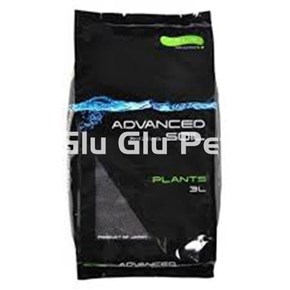
3.- TYPES OF INERT SUBSTRATES: SANDS AND GRAVELS.
Inert substrates are basically made up of gravel and sand, with an almost infinite number of options, in terms of size and color.
It is important that when you are making the purchase decision, you discard artificially colored sand or gravel, as they usually have chemical components that can be toxic to fish.
Inert substrates are those that do not interact with the aquarium water, and therefore do not modify the parameters of pH, gH, etc.
Beginning aquarists often start with this type of aquarium substrate, because it doesn't require a lot of attention or water analysis.
The drawback is that in the long term they are not very useful on their own, since they do not contain organic matter, and they do not provide any nutrients to aquarium plants.
In a FAD, the ideal is not to create a bottom 100% composed of inert substrate, but combined with some type of nutritious substrate for a planted aquarium.
We classify inert substrates according to grain size and mineralogical composition:
- sand for aquariums
- Gravel.
3.1.- ADVANTAGES AND DISADVANTAGES OF SUBSTRATES FOR INERT AQUARIUMS.
Like any choice you make to set up your aquarium, you will find positive and negative aspects.
As advantages in Glu Glu Pet it is highlighted that:
- They do not influence the quality of the water.
- As they do not modify the quality of the water, they allow us greater control over the parameters of the aquarium.
Of its advantages, its main disadvantage appears:
We cannot place aquarium plants that need a substrate to survive or to hold on.
They have to feed through the leaves.
2.2.2.- SAND FOR AQUARIUM.
Aquarium sands have thicknesses between 0.5 to 2 mm thick.
This thickness is called granulometry, and you will find coarser and finer sands.
Before deciding on sand, you have to know the advantages and disadvantages of this substrate:
- Sand can cause problems in the long run because it tends to compact, interrupting the cycle of water and air, creating anaerobic conditions.
- In the sands everything is not going to be bad, they are very decorative. In combination with other elements, such as plants, gravel, rock or logs, it creates a great feeling of naturalness and originality.
- We can choose to use them as a complement and place them in certain areas of the aquarium where there will be no plants, or also as a final cover, on a main substrate.
The inert substrate with the smallest granulometry, the smallest grain size, is aquarium sand. Aquarium sand has thicknesses from 0.5 to 2 mm.
A substrate as fine as aquarium sand can cause long-term problems, because over time it compacts and interrupts the flow of water through its particles, generating anaerobic conditions in the soil, without oxygen, which lead to stagnation and release of toxins.
Therefore, fine aquarium sand should not be used as the sole substrate for a planted aquarium.
Yes, it is widely used by aquascapists, or aquatic landscapers, such as the famous Takashi Amano, to create sand clearings or small paths between plants, giving a lot of play in the decoration of the planted aquarium.
The first option: combine the sand with another type of aquarium substrate.
In this case, the aquarium sand would only have a decorative function, and we would reserve it for the areas of the aquarium in which we are not going to plant any species.
It would be placed on the substrate that we use as the main one, in a thin layer of no more than 2 or 3 cm thick.
We could form paths or clearings of sand.
The second option:
In some areas we would put only nutritious substrate for planted aquarium, in the areas where we are going to plant, generally in the back of the aquarium and in other areas we would put sand for aquariums, where we are not going to plant, ideally in the front area of the aquarium, the which gives the observer
Both options are very interesting if we want to make an Iwagumi or aquascaping aquarium.
Remember that you should avoid sand for aquariums with a calcareous composition.
Instead you can buy silica sand for aquarium or other inert nature.
- White diatomaceous sand.
- Brown diatomaceous earth.
- Black diatomaceous sand.
- JBL MANADO.
- JBL SANSIBAR DARK 5kg.
- JBL SANSIBAR RIVER 5KG.
- JBL SANSIBAR WHITE.
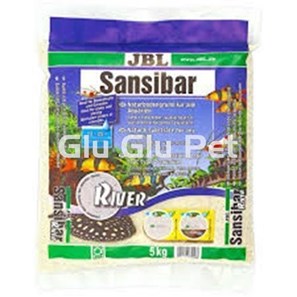
What differentiates gravel from sand is size.
We speak of gravel when the size of the granules is between 2mm and 5mm.
Thanks to their size, they allow water and air to flow through them, facilitating the exchange of oxygen and preventing harmful toxins from appearing in the aquarium ecosystem.
As an inert material, they do not influence the parameters of the aquarium, although they fulfill their primary function, favoring the appearance of beneficial bacteria.
They can be used alone or in combination with other substrates, being equally decorative, such as sand.
Aquarium gravel is an inert aquarium substrate with a granulometry greater than aquarium sand, with grains between 2 and 5 mm.
Thanks to their larger grain size, they allow a good flow of water through the floor of the aquarium, facilitating the exchange of oxygen, the supply of nutrients from the water column, fish excrements or some food remains and avoiding stagnation and appearance toxins harmful to plants.
Being inert, they do not change the parameters of the aquarium, which can be an advantage and they do not provide any kind of nutrient to the aquarium plants on their own, but they still fulfill an important function.
Aquarium gravels are very useful in the following cases:
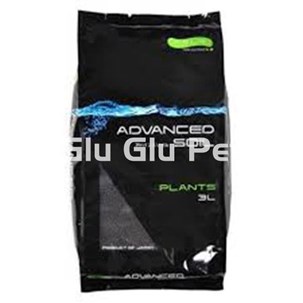
3.2.- SAND FOR AQUARIUM.
3.3.- JBL SANSIBAR RANGE OR DECORATIVE AQUARIUM SAND:
JBL's Sansibar aquarium sand range offers an interesting variety of granitic decorative sands.
They are totally safe sands, since they do not release carbonates into the water.
Aquarium sands should not be used for planting an aquarium, although plants are capable of growing in sand, it is not the most optimal medium.
The sand has such a fine granulometry that it is compacted by the pressure of the water and blocks the flow of water inside it.
This means that the substrate is not oxygenated, the roots of the plants can rot, and gases accumulate due to anaerobic bacterial activity.
The ideal is to use the sand for decorative purposes.
You can place it in the areas where you are not going to plant, forming paths, rivers, underwater flows, esplanades that surround islands of vegetation, etc.
The Sansibar range has a wide variety of colors that you can use, from reddish or orange sand to black, white, grey, mixed, etc. If you combine them well, you can create impressive effects in the aquarium.
Generally, the grain size varies between 0.2 and 0.6 mm.
They are sold in bags of 5 and 10 kg.
At Glu Glu Pet we recommend:
3.4.- JBL PROSCAPE VOLCANO MINERAL:
This volcanic stone substrate is perfect for placing UNDER nutritious substrates such as HELP, ADA or similar. This is how many aquascapists do it with great results.
It provides aquatic plants with a base of porous and thick material in which to root easily, in addition to allowing a good flow of water under the substrate, oxygenating and avoiding anaerobic conditions.
It is also a good base for placing natural rocks or logs in aquascapes as this aquarium substrate does NOT slip or sag.
In addition, it is an extra source of minerals and trace elements.
It is sold in bags of 3 and 9 litres.
4.- CLAY SUBSTRATES FOR THE AQUARIUM:
Although clays could, or should, be classified as an inert substrate, the truth is that if they have the ability to change the parameters of the water, that is why they deserve a separate chapter.
Clays contain nutrients such as iron, aluminum oxide or magnesium, and release them into the aquarium over a long period of time.
They also have another very curious quality. They have the ability to exchange ions.
They are charged with negative particles, which attract positive ones, such as calcium or magnesium, which makes it easier for them to be absorbed by plant roots.
It is not usual that they are used as the only substrate, rather as a complement to a nutritious substrate, at the bottom of the aquarium and mixed or under an inert substrate.
It should not be used as a cover substrate, as they contain dust particles, which leave the water cloudy for a long time, until they settle.
I think it is interesting to list the advantages and disadvantages that you will find when using clay as a substrate.
Clay or laterite substrates have a high content of nutrients such as iron, aluminum oxide, magnesium, etc. that they release over a long period of time.
Also, they are good at exchanging ions. Clay is made up of negatively charged particles, which will attract positive molecules like calcium, magnesium, and other nutrients. In this way, they will facilitate its absorption by the roots of aquatic plants.
They are often used as a supplemental substrate, as only a small amount is needed.
They are reddish in color and have a very fine granulometry, almost powder, so you have to be very careful when introducing them into the aquarium. Ideally used as a third layer, below the main nutrient substrate and inert gravel, or mixed with the main nutrient substrate below the gravel.
It should never be put on the surface layer, as it can leave the aquarium water cloudy for a long time, the dust particles weigh very little and take a long time to settle.
You also have to be very careful when removing a plant or removing the substrate. It is only recommended for experienced aquarists, as handling it incorrectly or carelessly can lead to disaster.
Its advantage is that it has a concentration of nutrients, and it is much more profitable than other commercial substrates.
4.1.- ADVANTAGES AND DISADVANTAGES OF CLAY SUBSTRATES:
Advantages:
- They help to harden the water, lowering its pH and therefore its hardness.
- Because they have negative charges, they help retain nutrients and allow them to be absorbed by plants.
- They improve the circulation and oxygenation of the water.
- They help hold down the roots of aquarium plants.
- They facilitate the appearance of bacteria, helping to improve the health of the aquarium through biological filtration.
Disadvantages:
- By moving the clay substrate in the aquarium, we will create a little chaos. The water becomes cloudy and brown in color.
- Their presence influences the quality of the water and its parameters. Sometimes it is difficult to stabilize them.
In short, they are a very interesting option to consider, halfway between inert and nutritious substrates, but they must be treated with caution and they may not be the most advisable substrates for novices.
Three types of clays can be found for sale:
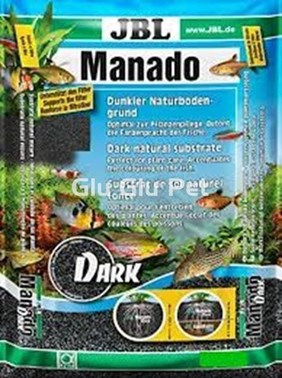
5.- WHAT TYPE OF FLOOR TO LAY ACCORDING TO THE LEVEL OF EXPERIENCE:
If you are a beginner, you can choose to:
1) Bottom composed of 100% inert gravel. Do not use sand to plant, only as a decoration if you want in areas without plants. All the nutrients that the plants lack will have to be paid manually.
The advantage is that you will control at all times what nutrients are in your aquarium. You can see here how to make a complete subscription of the aquarium.
2) Bottom composed of nutritious substrate in the areas where you are going to plant, sealed with a layer of inert gravel on top. Highly recommended. You can enjoy the advantages of having a nutrient, and the advantages of not having it.
If you have experience in FADs:
1) Nutrient substrates as a single background element, or combined with gravel and decorative sand.
If you are going to completely cover the bottom with nutrients, you will have to fill it with plants that take advantage of said substrate from minute 0. Otherwise, you will have important chemical imbalances.
It is best that you use the nutritious substrate only in the areas where you are going to plant. In the rest, you can use inert gravel or sand.
2) Soil-type nutrient substrate (very experienced).
6.- HOW TO CALCULATE THE QUANTITY OF SUBSTRATE FOR A PLANTED AQUARIUM:
After reading about all the types of aquarium substrate that exist and how to use them, you may be wondering how to calculate the amount of gravel in an aquarium: that is, how many liters of substrate do you have to buy to get a layer of 8, 4, 6 cm , etc.
The calculation is very simple:
Record the length x width x height measurements of your aquarium. For example, imagine that it measures 120 x 50 x 40 cm.
Replace the height of the aquarium (in this case 40 cm) with the thickness of the aquarium substrate you want. In this case we will put 8 cm thick.
120 x 50 x 8 cm = 48000 cm3 = 48 Liters.
You would need a total of 48 liters of substrate to get an 8 cm thick layer of substrate in your aquarium.
Many bags of gravel and nutrient substrate for aquariums come in liters, you just have to know how many bags you need to reach 48 liters of substrate.
Other articles that may interest you:
- Diseases of the Drunken Fish.
- Varieties of the Pez Borrachito.
- The Lemon Tetra is one of the most beautiful fish for a community aquarium.
- Chinese neon or White Cloud Mountain fish, named for its place of origin in southern China.
- Black neon tetra.
- Neon Tetra or Neon Innesi, is a warm and fresh water fish.
- drunk fish.
- The best care of the Tetra nun.
- Aquarium maintenance.
- What do you need to have your first aquarium.
- The best tropical freshwater fish recommended for beginners.
- The best aquarium plants for beginners that you should know.
- The best plants for cold water aquariums.
- The best groundcover plants for your aquarium.
- Aquascaping for beginners.

